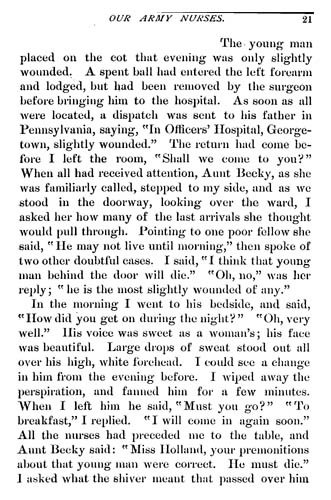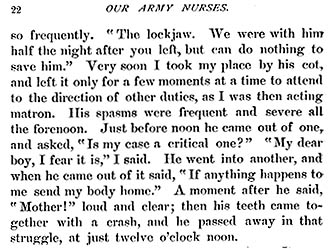
|
After the War came the retrenchment, the attempts to restore the "normative" gender relations that the War had called into question. Institutions of all kinds rejected the aberrations and confusion in gender roles that the war had spawned, and worked instead to restore the "natural" and complementary relationship between masculinity and femininity, men and women. These passages comes from an 1896 memorial volume called Our Army Nurses, and registers rather precisely the post-War reliance on a sentimentalized and heroic image of women's virtue as maternal substitutes. It is important to note that these memorial volumes rarely mentioned the 400 Northern women who had cross-dressed as soldiers in order to contribute to the field of battle.
|

|
Note carefully the gender crossing here, feminizing the dying solider on his deathbed.
|
|
St. Clare from Uncle Tom's Cabin and the soldier here share the same dying word.
|

|
|
Historian Jeanie Attie concludes thus:
The ceaseless production of sentimental narratives about female sacrifice attested to the felt need by some northerners to make visible the dimensions of women's contributions to the Union clause. Such stories also suggested, however, an effort to dictate the political meanings attached to women's political labors. If nothing else, the stream of romanticized stories about magnanimous women who acted out of instinct and moral temperament to support the state hinted at the war's potential to upset customary assessments of women's unpaid labors. . . . Because the American Civil War, which depended so heavily on popular voluntarism, expanded the space for female economic and political participation, the disjuncture between the realities of women's lives and the myths embedded in the antebellum compromise threatened to become visible. (18) |


